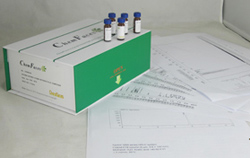Hot Products



| Catalog No. | Information |
| CFN98955 | Platyphyllenone Platyphyllenone has shown promising anti-filarial activity both in vitro and in vivo studies. It can inhibit the biosynthesis of violacein in C. violaceum CV026. |
| CFN00403 | Platyphylline Reference standards. |
| CFN98644 | Platyphyllonol Platyphyllonol-5-xylopyranoside is moderately active against KBNP-0028 (H9N2) avian influenza virus as compared with zanamivir. |
| CFN90444 | Plumbagin Plumbagin, a potential natural FOXM1 inhibitor, has anticancer, and anti-fibrotic activies, it inactivates the NF-κB/TLR-4 pathway that is associated with inflammatory reactions, thereby mitigating liver fibrosis. Plumbagin offers significant protective role against DEX-induced cellular damage via regulating oxidative stress, apoptosis, and osteogenic markers. |
| CFN92059 | Pluviatolide (-)-Pluviatolide can inhibit electrically-induced and acetylcholine-induced contraction in the isolated guinea-pig ileum. |
| CFN70237 | p-Mentha-1,4-diene p-Mentha-1,4-diene may possess strong antimicrobial and antioxidant properties. |
| CFN99168 | Podophyllotoxin Podophyllotoxin(Podofilox ) is a potent inhibitor of microtubule assembly and DNA topoisomerase II. Podophyllotoxin has antitumor and antiviral properties, but it also shows cytotoxicity for normal cells and hence side effects derived from its lack of selectivity against tumoral cells. |
| CFN90555 | Pogostone Pogostone possesses potent anti-bacterial and anti-fungal activities, it also exhibits an immunosuppressive property by directly blocking T cell proliferation as well as altering inflammatory cytokine profile. Pogostone could exert a gastro-protective effect against gastric ulceration, and the underlying mechanism might be associated with the stimulation of PGE2, improvement of antioxidant and anti-inflammatory status, as well as preservation of NP-SH. |
| CFN99714 | Poliumoside Poliumoside is a natural compound which exhibits significant inhibition of advanced glycation end product formation with IC50 value of 4.6-25.7 μM, it also exhibits great inhibitory effects on rat lens aldose reductase with IC50 values of 0.85 μM.Poliumoside has oxidant scavenging, antibacterial and hemostasis capacities, it can inhibit Biofilm-forming Staphylococcus aureus in mice. |
| CFN96834 | Polpunonic acid Polpunonic acid is a natural product from Tripterygium wilfordii Hook.f. |